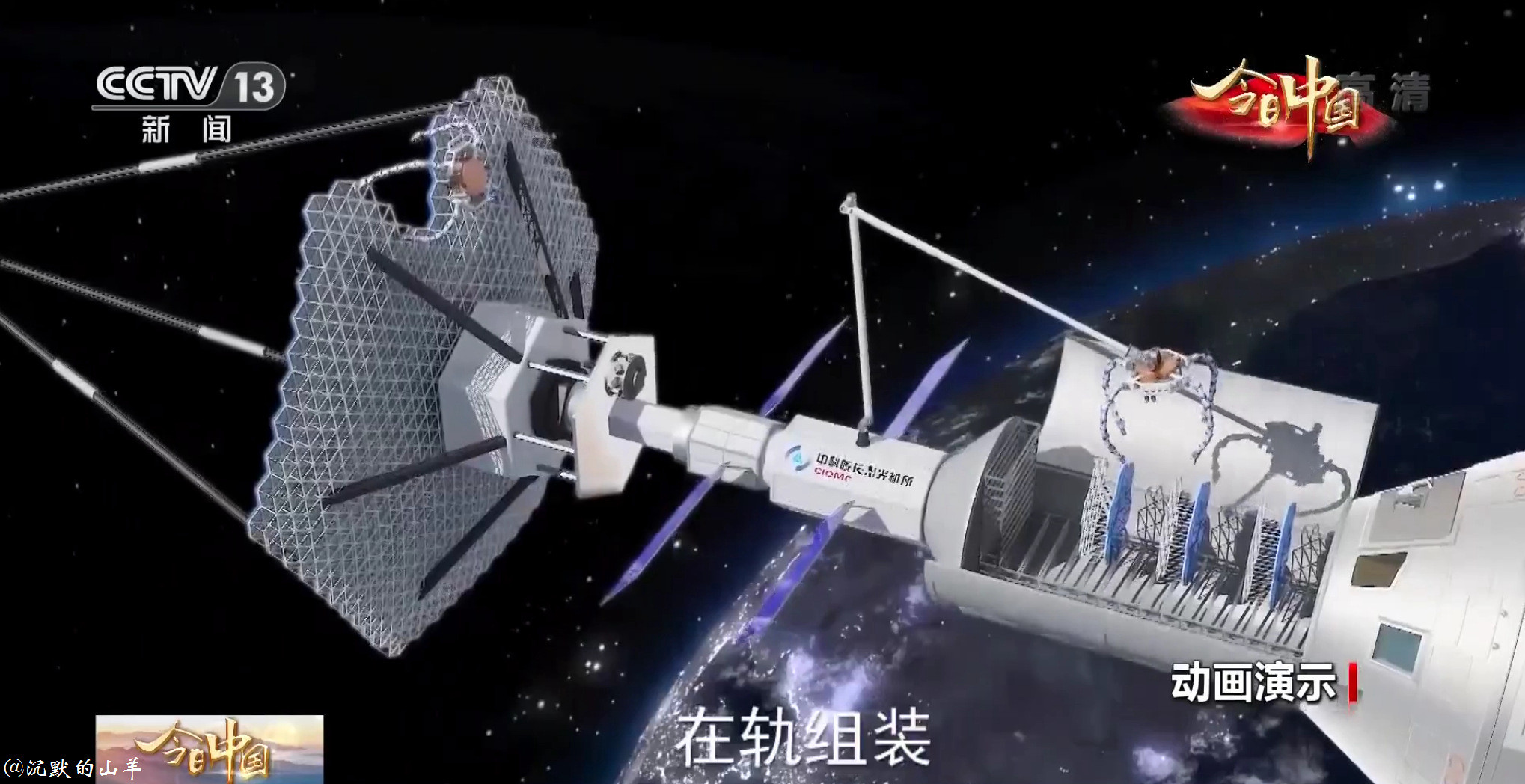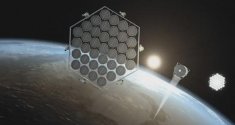You are using an out of date browser. It may not display this or other websites correctly.
You should upgrade or use an alternative browser.
You should upgrade or use an alternative browser.
China's Space Program News Thread
- Thread starter crazyinsane105
- Start date
- Status
- Not open for further replies.
China's large aperture space telescope has entered formal engineering stage. Deployment may begin as early as 2025. The telescope will be assembled in space.




They can use this as a blue print for how to assemble spaceships in orbit.
The team behind the space station robotic arm.

Amazing work by this team.
Cannot wait for this to be a reality.China's large aperture space telescope has entered formal engineering stage. Deployment may begin as early as 2025. The telescope will be assembled in space.




and the vitality of YOUTH too.View attachment 72230
Brain and beauty in one package!
Indeed, if completed this will be an extraordinary example of space construction.They can use this as a blue print for how to assemble spaceships in orbit.
Having done some amateur astronomy with a small Newtonian telescope let me explain why it's hard: that big mirror is not spherical but rather a section of a parabola. The parabolic shape allows incoming light (which are travelling parallel since it comes from distance measured in light years) to be focused to the detector at the focal point. Using a spherical mirror instead of a parabolic mirror will cause a major optical defect in focusing called "spherical aberration" which will make this telescope useless.
Because the primary mirror is a section of a parabola it means all the mirror segments are actually different and not interchangeable. Not only that when you assemble a segmented primary mirror each segment have to be aligned accurately to a small fraction of the the wavelength of the light you're measure (in other words, the mirror has to look "smooth" on the scale of visible light photons), so for visible light we're talking accuracy of around 10 nanometers. If a segmented mirror is not correctly aligned it's as if a single big glass mirror has lots of bumps in it which will not be acceptable.
For that sort of accuracy it means both the overall mirror segments have to be aligned to quite good accuracy, then each mirror segment have to be further finely aligned using machinery built into the back of them called "active optics" which basically means lining up the back of the mirror with lots of tiny actuators that can adjust them.
JWST for example uses this technology and has seven actuators per mirror segments (one per corner and one in the middle, with 18 segments all together). This big Chinese telescope will need at least 7 per segment as well. Note that these nanometer accurate actuators can only move very tiny distances, so the overall mirror assembly still has to be done to very high degree of accuracy first.
You might hear the world "adoptive optics" when dealing with reflecting telescopes. This is a similar technology but involves much more actuators per mirror segments. These actuators are not only responsible for tilting the segments to align them, but also flexing the mirror by tiny amount (and adjusting the flex in real time) to compensate for atmosphere seeing. Since space telescopes are above the atmosphere they do not require this much more elaborate system.
Official response regarding photos from Martian surface:
On the day of the landing the lander will be talking to earth via direct communication. In this mode the bandwidth is 16bps, so 2 bytes per second. At this speed the comms is only sufficient for judging spacecraft status and not enough for transmission of photos. A 100KB uncompressed low resolution photo will take 14 hours to transfer at this rate, and this is not taking into account Zhurong's own bandwidth requirements. 3 Sols after landing (Monday night, 17/05/2021) the rover will attempt first UHF communication with Tianwen-1 in orbit, and each transmission attempt will last 8-10 minutes. Once established each day it will support 20Mbit (2.5MB) of data. Then after this every 3 days the rover will attempt to establish X band communication, this channel will support 50Mbit (6.25MB) of data per connection. Thus tonight (night of 17/05/2021) first data pack of 2.5MB should arrive, hopefully this 2.5MB data pack will have some post landing photos. If not worry not, more data will come in the coming days, sooner or later you will see first photo from the Martian surface.
People probably aren't going to be impressed with low resolution photos and trying to cram a high resolution photo in the 2.5mb data isn't really a good use of that bandwidth since there are lots of other things needing to be sent back to earth I'm sure.
Many people are asking how come there still aren't any photos from Zhurong yet. It's been three days since landing and still no photo back, is there a problem blablabla. Don't be so hasty, we will analyse the reason behind lack of photo.最近很多人问为什么祝融号到现在依然没有图片回传?着陆两三天了都还没回传是不是有问题balabala,诶,这可别着急,下面就分析一下为什么直到现在都没有照片的原因,如图所示(资料来源 ),落火当天使用的是自主的直接对地通讯方式,这个对地通讯模式的传输速率仅仅为16bps,也就是一秒传输2个字节,在这种带宽下,仅仅只能判断探测器状态,极其难以实现图片回传,如果一张100KB的低清图片没有经过压缩的话,使用这个小水管回传需要大概14小时左右,这还是不考虑祝融号本身测控的所占用的带宽,但是,在三个火星日之后,也就是今天晚上呢,火星车会和在轨道上面的天问一号第一次尝试建立UHF通讯链路,每次持续8-10分钟,建立以后每天能够回传20Mbit(2.5MB)的数据,再之后每3天会建立一次X波段的通讯链路,这种通讯链路的每次通讯的数据就达到了50Mbit(6.25MB)的数据,所以,如果一切都顺利的话,今天晚上可能拿到祝融号的第一批大小约为2.5MB的数据,就让我们敬请期待这2.5MB小小的数据包里面有没有着陆后的照片吧。如果没有也不要灰心,再等几天,数据会陆续的传回来,相信早晚会看到我国第一张从火星表面发来的照片的!
On the day of the landing the lander will be talking to earth via direct communication. In this mode the bandwidth is 16bps, so 2 bytes per second. At this speed the comms is only sufficient for judging spacecraft status and not enough for transmission of photos. A 100KB uncompressed low resolution photo will take 14 hours to transfer at this rate, and this is not taking into account Zhurong's own bandwidth requirements. 3 Sols after landing (Monday night, 17/05/2021) the rover will attempt first UHF communication with Tianwen-1 in orbit, and each transmission attempt will last 8-10 minutes. Once established each day it will support 20Mbit (2.5MB) of data. Then after this every 3 days the rover will attempt to establish X band communication, this channel will support 50Mbit (6.25MB) of data per connection. Thus tonight (night of 17/05/2021) first data pack of 2.5MB should arrive, hopefully this 2.5MB data pack will have some post landing photos. If not worry not, more data will come in the coming days, sooner or later you will see first photo from the Martian surface.
People probably aren't going to be impressed with low resolution photos and trying to cram a high resolution photo in the 2.5mb data isn't really a good use of that bandwidth since there are lots of other things needing to be sent back to earth I'm sure.

I recall China has some interest in space based solar power, and the designed called for two big mirror arrays focusing sunlight to a centre collecting point which will convert it into microwave and beam it to the ground.
I can't help but think the techniques that will be developed for assembling the 10m space telescope will be useful for the orbital solar power plant too.
- Status
- Not open for further replies.

